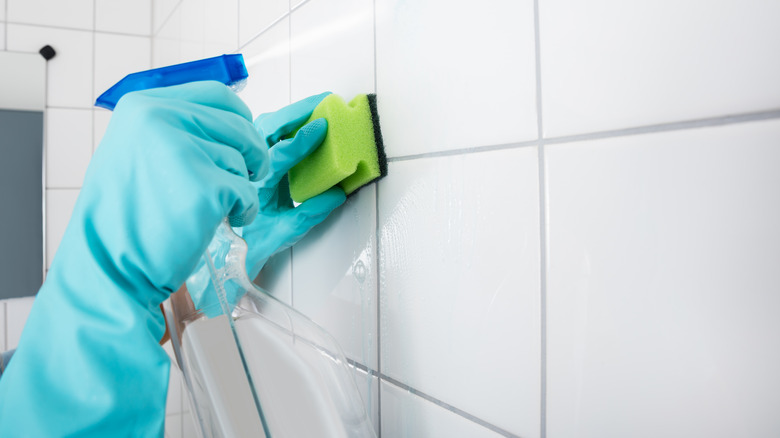Different Methods To Safely Remove Moldy Caulk
Having mold in your home is unsightly and could be downright dangerous. The Centers for Disease Control and Prevention (CDC) warn that fungal growth can cause mild symptoms of sore throat, congestion, fatigue, wheezing or coughing, and even skin conditions. But those with allergies, compromised immune systems, or respiratory conditions like asthma or other chronic lung diseases can suffer from more serious ailments like allergic reactions or infections.
Mold thrives in places with humidity, so you'll often find it growing over caulk at the base of your toilet, in your shower, or around the sink in the bathroom. The hot water and steam from your shower create the perfect condition for it to spread whenever you bathe or wash your face and hands. To prevent the spread of this fungus, you'll want to keep the bathroom as ventilated as possible so the humidity can exit the area. Keeping all surfaces dry after you shower or use them is also recommended.
When tackling any mold accumulated in these areas, ensure you're doing so safely by wearing non-porous gloves and a mask to prevent breathing any of it in. When scrubbing, be sure not to break your caulking's seal. This can make the surface porous making the fungus harder to eliminate. You can use several methods to remove mold depending on how harsh of a chemical substance you're comfortable with using in your house.
Bleach to the rescue
When we think of getting rid of mold in our home, cleaning with bleach probably comes to mind. When mixed with water, the chemical's main ingredient, hypochlorite, will turn into hypochlorous acid, which acts as a biocide, killing organisms like bacteria and fungi by destabilizing its proteins and other crucial cellular components. This household product should only be used to clean spores from non-porous surfaces, like caulk, as it can be ineffective in penetrating porous surfaces deep enough to eliminate the problem fully.
First, read the label on your bleach bottle to ensure you take all necessary safety precautions. Since chlorine-based bleach is noxious and harmful when inhaled, ingested, or even placed on the skin, it's critical that you have adequate ventilation, gloves, and eyewear when using bleach. You might also want to consider wearing a mask.
The CDC advises against mixing bleach with ammonia or other common household chemicals. It should also be diluted with a gallon of water for every cup. Pour this mixture into a spray bottle and squirt directly over the affected surface. This solution should sit on the surface for at least 10 minutes for best results. Scrub the area with a brush before rinsing it with water to completely remove any mold killed by the bleach. Be sure to thoroughly wash or toss out any utensils you use to clean mold.
Vinegar works, too
If you're not big on using harsh chemicals in your home, vinegar is a wonderful natural alternative. White vinegar contains antifungal and antibacterial properties capable of killing 82% of all mold species. The acetic acid has a pH level of 2.5, halting the fungus' growth. It's also effective in preventing future buildups. So, spray some on your shower walls when they are dry.
When using vinegar to kill small amounts of household mold, choose one with 5% acidity or higher. Most bottles in the grocery store contain between 5 to 8%. Because of its acidic and pungent nature, you'll also want to glove and mask up before cleaning.
Pour your vinegar over the moldy space and let it work its magic for a good hour. Scrub it with a brush until all evidence of the fungus buildup is removed. Wipe dry with a clean rag that you can throw out. Mix 2 or 3 teaspoons of baking soda with a cup of white vinegar to create a paste and spread this over the affected area for tougher stains. You can adjust the measurements to create the proper consistency. Leave on for five minutes before scrubbing, then rinsing with cool water.
The ammonia method
Like bleach, ammonia is a potent chemical that kills mold on non-porous surfaces. Mixing the two can actually be fatal. But cleaning with just one of them will do. Ammonia is highly toxic, so you'll want to open windows and keep your cleaning area ventilated. It's also recommended to wear safety protection over your hands, eyes, and mouth when using it. Most household-use bottles are pre-diluted and have a 3 to 5% concentration. So, you don't have to dilute further if you don't want to. But since its fumes are so strong, you can mix 1:1 with water.
The best way to get rid of mold with ammonia is to put it in a spray bottle and squirt the area thoroughly. It should stay on your caulk for about two to three hours. Rinse clean with water. For stubborn stains, soak a paper towel in your mixture, press it over the area, and let it sit for four to five hours. After you remove it, scrub the area with more of the mixture and a brush before rinsing clean.



